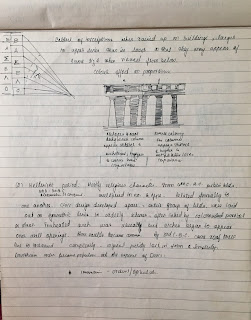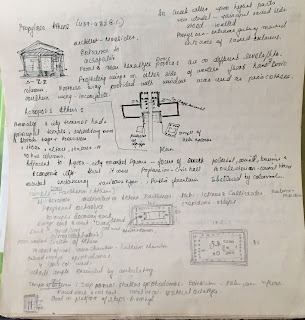As mentioned in my earlier posts, these notes are references made from Sir Bannister Fletcher's History of Architecture. This post covers the period from Hellenic period to the Hellenistic period.
 |
| Greek Architecture |
The ancient Greeks, unlike their Minoan and Mycenaean
ancestors, did not have the royalty and therefore had no need for palaces.
Hence you will find their architecture dedicated to public buildings such as
temples, central market place (agora) covered wit colonnade (stoa), monumental
gateways (Propylon), the council building (bouleuterion), open air theatre,
gymnasium(palaestra), and so on. Amongst these buildings it is the temples that captured the essence of Greek Architecture.
Effort was made to build temples in prominent positions using
geometry and optical tricks such as thickening the lower parts of the columns,
thickening the corner columns, etc. Such refinements indicate that the Greek
temples were not just functional structures but also were symbolic and an
important element in the civic landscape.
The notes consists of brief architectural characteristics of temples, geometry and optical tricks employed, sketches showing Greek Mouldings. Important buildings such as Propylaea Athens, the Acropolis, temple of Parthenon, temple of Artemis, theatres, public buildings and domestic buildings are also mentioned.
 |
| Page 01 Hellenic Period |
 |
| Page 02 Hellenistic Period |
 |
| Page 03 Acropolis Athens, Temples of Parthenon, Artemis |
 |
| Page 04 Temples |
 |
Page 05 Greek Mouldings
 | Page 06 Theatre, Public Buildings
|
 | | Page 07 Domestic Buildings |
For more details on the Greek orders of Architecture (Doric, Ionic and Corinthian), please refer to the extra notes that will posted later.
Hope you find the above notes useful.
Thank you for stopping by. Have a nice day! |









No comments:
Post a Comment